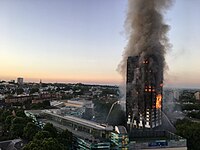
Photo from wikipedia
Abstract Many fire models have been proposed to investigate structural response to fire, where fire is considered as a structural “load” and the structural response determines the “resistance” offered by… Click to show full abstract
Abstract Many fire models have been proposed to investigate structural response to fire, where fire is considered as a structural “load” and the structural response determines the “resistance” offered by the structure. Where the term “resistance” is used with its physical meaning and is not restrained by its standard application. Over the course of time, fire models have evolved from simply using the highest gas temperatures resulting from a fully developed compartment fire to more sophisticated computational fluid dynamics (CFD) models, where hyper-realistic time-varying structural temperatures can be determined for a range of realistic fire scenarios. This paper examines the current state of the art in terms of defining gas temperatures for structural fire analysis. Widely adopted fire models used in structural analysis are therefore reviewed. This paper discusses the limitations and scope of applicability of the most commonly used fire models. Recent developments on the coupling of CFD and FEM models are also discussed in detail and their applicability to practical fire scenarios is explored. The primary concern of this review is to evaluate the fire models for their suitability while using for structural fire assessment and not to review studies on the manner in which the actual structural assessment is done.
Journal Title: Fire Safety Journal
Year Published: 2021
Link to full text (if available)
Share on Social Media: Sign Up to like & get
recommendations!